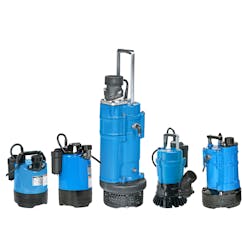Tsurumi’s Automatic Moisture-Sensing Pumps offer Durable Stainless-Steel Probes
Posted by Brooke Just
Dewatering pumps featuring electric probes that detect rising water levels to prevent dry running are becoming more favorable in the construction and industrial market since there’s a tangible need for such automated technology, according to Tsurumi Pump. Although the company has produced these pumps for several years, a variety of factors such as product enhancements, rising energy prices, labor shortages and the increased appetite for the benefits that the technology can offer mean Tsurumi is now gearing up to meet an anticipated rise in demand across North America.
Tsurumi’s KTZE and KTVE series pumps, for example, take the performance of its KTZ and KTV models and enhance it through the incorporation of a durable, fixed-position stainless-steel probe on the pump head cover, connected to an internal relay unit. When this e-probe comes into contact with water or other conductive media, a signal is sent to a timer. If the contact lasts for more than one second, a continuous low-voltage electric circuit is formed between the probe and the pump body, acting as the ground, prompting the relay to switch on the pump. Once the water level has receded below the level of the probe, the pump will continue to operate for a further 60 seconds before shutting off, reducing the chance of short cycling caused by potential turbulence in the water, preventing the pump from running dry.
By preventing unnecessary dry operation, damage on the wear parts is minimized, extending the lifespan of the pump.
“This makes these pumps ideal for any dewatering application where an operator isn’t present to manually turn them on and off according to water levels,” said Mike Klimes, applications engineer at Tsurumi. “To enable automatic operation, you would typically need to utilize a tether float switch, suspension probe, or pressure transducer in addition to an automatic control panel.”
Instead, the Tsurumi models use the far simpler and less expensive approach of a moisture-sensing electrode control device, thereby enabling the costly automated control panel to be replaced with a much simpler manual panel – an immediate cost saving that is soon followed by significant energy savings due to the shorter operating time.
Safe from harm
The e-probe technology complements the robust and durable nature of the pumps to which they are attached. Unlike a design relying on tethered float switches, the robust probes do not stick out beyond the pump’s footprint and are therefore at little risk of damage. This enables them to easily withstand the inevitable rough handling at the job site as they are unloaded from a truck to the ground and then on to the final location.
“These pumps are frequently lowered down pipes that provide access deep underground for dewatering,” Klimes explained. “External cables would typically get tangled up in that situation, but that’s not an issue when you’re using electrode pumps. Also, when you’re in a tight space, floats don’t always work very well, and erosion can cause a build-up of debris that will make them even less effective. All of that will have a negative effect on the lifespan of the pump, so our electrode solution promises greatly improved efficiency and less downtime overall.” A probe cover will soon come standard with these pumps, eliminating the possibility of the electrode being damaged during transportation or severe-duty operations.
Designed to last
Tsurumi’s KTZ and KTV pumps have long been renowned for their high performance and reliability. With a durable cast iron body, the KTZ series is designed for demanding applications and is easily convertible between high-pressure and high-volume configurations. It features high-chrome impellers to withstand the highly abrasive liquids found in construction, aggregate and mining applications, while dual silicon carbide mechanical seals are isolated in the oil chamber to protect the seal faces from abrasion and corrosion.
The KTZE moisture-sensing variant is available on models between 2-5 hp, handling 110-385 gal/min at head requirements of up to 82 feet. Offering a weight saving of approximately 25 pounds compared to cast iron pumps, the compact, wear-resistant KTV models have been designed for light- to medium-duty applications. Their slimline die-cast aluminum body and elastomer pump end provide easier handling. A semi-vortex impeller allows for maximum particle passage size while offering extended parts life.
The need for impeller efficiency adjustments has also been eliminated, and the pumps are immune to calcium carbonate deposits. The e-probe KTVE range comprises four models ranging from 85 to 220 gal/min, at head requirements up to 85 feet. Other Tsurumi pumps incorporating the technology include the HSE and LBA models, and the forthcoming LSCE range.
“These e-variant pumps combine all the brawn of their standard siblings with a clever probe that will turn them on and off automatically,” Klimes said. “The effective automation they provide can be extremely helpful in a wide range of applications.”
Top 10 benefits of Tsurumi’s e-probe pumps
1. Avoid pumps from running dry
2. Design is robust and durable to withstand rough handling and transporting
3. More expensive automatic panel not needed
4. Great for jobsite dewatering where pumps are left unattended
5. Saves the pumps motor as it prevents failures
6. Probe is within the pumps outside diameter
7. Fits in tight spaces where floats don’t work well
8. No external cables connected to it
9. Leads to less downtime
10. Improves overall efficiency
